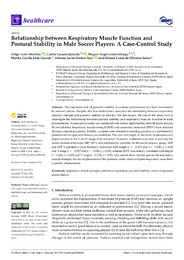Please use this identifier to cite or link to this item:
https://hdl.handle.net/11000/34720Full metadata record
| DC Field | Value | Language |
|---|---|---|
| dc.contributor.author | LEÓN-MORILLAS, FELIPE | - |
| dc.contributor.author | Lozano-Quijada, Carlos | - |
| dc.contributor.author | Lérida Ortega, Miguel Ángel | - |
| dc.contributor.author | León Garzón, Martha Cecilia | - |
| dc.contributor.author | Ibáñez Vera, Alfonso Javier | - |
| dc.contributor.author | De Oliveira Sousa, Silvana Loana | - |
| dc.contributor.other | Departamentos de la UMH::Patología y Cirugía | es_ES |
| dc.date.accessioned | 2025-01-16T19:29:40Z | - |
| dc.date.available | 2025-01-16T19:29:40Z | - |
| dc.date.created | 2021-05-29 | - |
| dc.identifier.citation | Healthcare (Basel) . 2021 May 29;9(6):644 | es_ES |
| dc.identifier.issn | 2227-9032 | - |
| dc.identifier.uri | https://hdl.handle.net/11000/34720 | - |
| dc.description.abstract | The important role of postural stability in exercise performance has been determined by several authors. Despite this, few studies have analyzed the relationship between respiratory muscles’ strength and postural stability in athletes. For this reason, the aim of this study was to investigate the relationship between postural stability and respiratory muscles’ function in male soccer players. A case-control study was conducted over twenty-eight healthy men (18 soccer players; 10 non-athletes). Inspiratory muscle strength (MIP) and respiratory resistance (MVV) were obtained through a digital spirometer. Stability variables were obtained in standing position on a stabilometric platform and in open and closed eyes conditions. The area and length of the center of pressures and displacements in the X and Y range were analyzed. Pearson’s coefficient was used to measure the linear correlation between MIP, MVV and stabilometric variables. In the soccer players’ group, MIP and MIP % predictive were inversely correlated with length (r = 0.535 and r = 0.585; p < 0.05) and X range (r = 0.527 and r = 0.560; p < 0.05), whereas MVV was directly correlated with length (r = 0.606; p < 0.01) and Y range (r = 0.558; p < 0.05). Our results show that the greater the inspiratory muscle strength, the less displacement of the pressure center, while at higher respiratory rates there is greater displacement. | es_ES |
| dc.format | application/pdf | es_ES |
| dc.format.extent | 8 | es_ES |
| dc.language.iso | eng | es_ES |
| dc.publisher | MDPI | es_ES |
| dc.rights | info:eu-repo/semantics/openAccess | es_ES |
| dc.rights | Attribution-NonCommercial-NoDerivatives 4.0 Internacional | * |
| dc.rights.uri | http://creativecommons.org/licenses/by-nc-nd/4.0/ | * |
| dc.subject | inspiratory muscle strength | es_ES |
| dc.subject | endurance respiratory | es_ES |
| dc.subject | postural stability | es_ES |
| dc.subject | center of pressure | es_ES |
| dc.subject | soccer players | es_ES |
| dc.title | Relationship between Respiratory Muscle Function and Postural Stability in Male Soccer Players: A Case-Control Study | es_ES |
| dc.type | info:eu-repo/semantics/article | es_ES |
| dc.relation.publisherversion | 10.3390/healthcare9060644 | es_ES |

View/Open:
Relationship between respiratory muscles and postural stability soccers in Male Soccer Players.A Case-Control Study.pdf
715,58 kB
Adobe PDF
Share:
.png)
